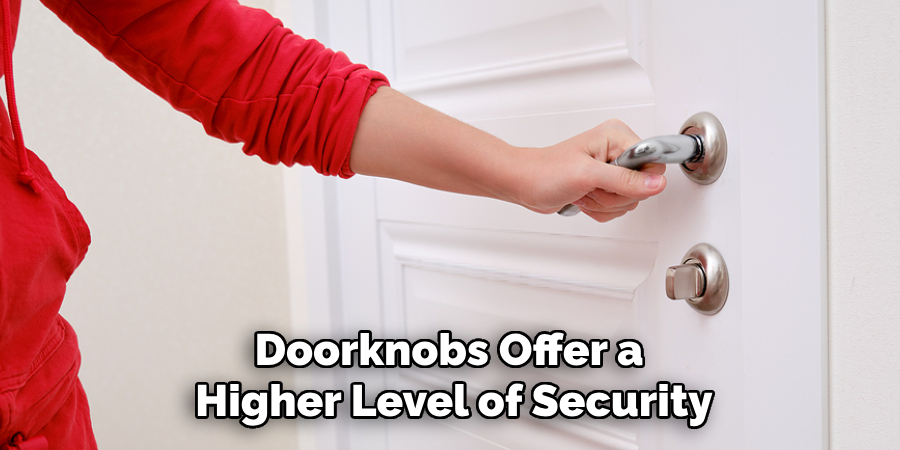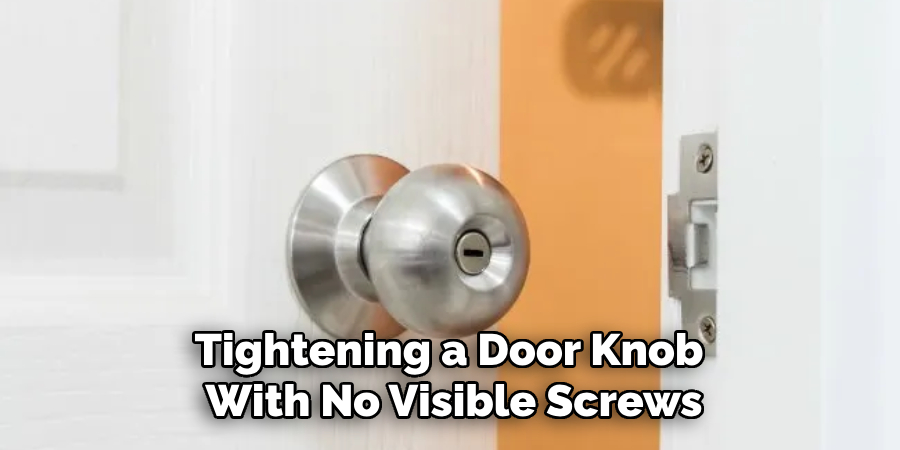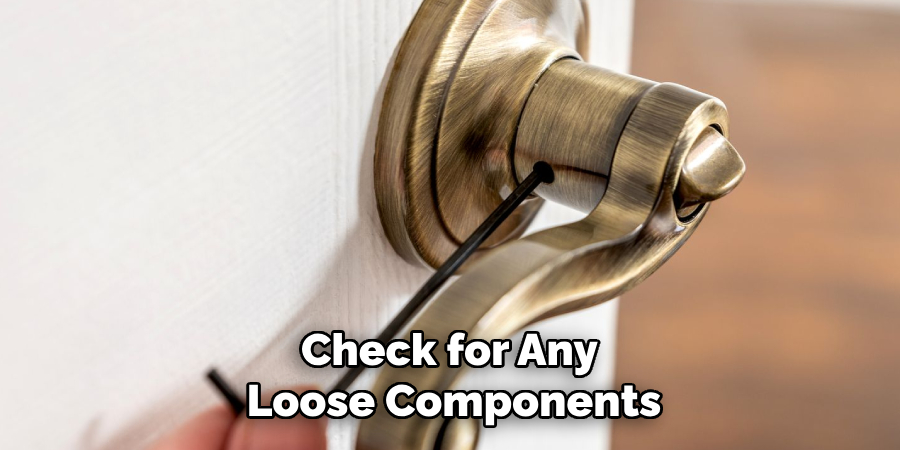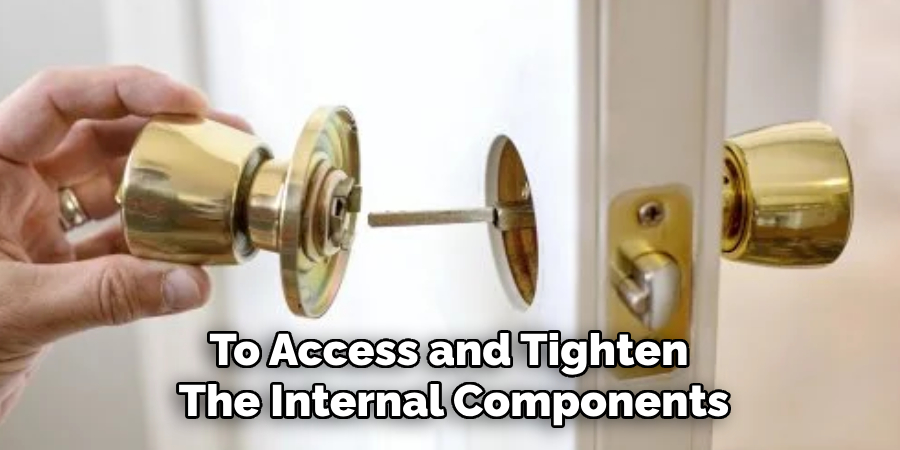A loose doorknob can be a frustrating and potentially security-compromising issue, but what do you do when there are no visible screws to tighten? Many modern doorknobs are designed with concealed fasteners for a sleek look, making the adjustment process a bit of a puzzle. In this guide, we’ll walk you through how to tighten door knob with no screws, demystifying the process and helping you restore your door’s functionality and appearance. From identifying hidden mechanisms to using the right tools, our easy-to-follow instructions will have your doorknob secure and sturdy in no time.

Importance of Maintaining a Secure and Functional Doorknob
Maintaining a secure and functional doorknob is essential for both safety and convenience. A well-maintained doorknob ensures that doors can be properly secured against unauthorized access, thereby providing peace of mind and an added layer of protection for your home or office. Beyond security, a functional doorknob contributes to the ease of accessing different areas within a building. A faulty doorknob can lead to frustrating experiences, such as being locked out or struggling to open a door.
Understanding Different Types of Doorknobs
When it comes to doorknobs, there is a variety to choose from, each catering to specific needs and aesthetic preferences. The most common types include:
Passage Doorknobs
Passage doorknobs are designed for doors that don’t require locking, such as those found in hallways or closets. They feature a simple latch mechanism that allows the door to open and close freely without the need for a key or locking button.
Privacy Doorknobs
Privacy doorknobs are ideal for bedrooms and bathrooms. They include a locking mechanism that can be engaged from the inside for privacy while allowing for emergency access from the outside, typically via a small hole or pin.
Keyed Entry Doorknobs
Keyed entry doorknobs offer a higher level of security and are commonly used on exterior doors. These doorknobs usually come with a key-operated lock on both the exterior and interior sides, ensuring secure access control.

10 Methods How to Tighten Door Knob with No Screws
Method 1: Inspecting the Door Knob for Hidden Screws
One of the first steps in tightening a door knob with no visible screws is to inspect the knob thoroughly for any hidden screws. Some door knobs are designed with a decorative cover or rosette that conceals the screws. Carefully examine the base of the door knob and the area where the knob meets the door. Look for any small indentations or seams that might indicate a removable cover. If you find one, use a flathead screwdriver or a thin object to gently pry off the cover. This will reveal the screws underneath, allowing you to tighten them with a screwdriver. This method ensures that you don’t overlook any concealed screws that are essential for securing the door knob.

Method 2: Using an Allen Wrench to Tighten the Set Screw
Many modern door knobs are secured with a set screw located on the side of the knob, which can be tightened using an Allen wrench. To access the set screw, locate the small hole or indentation on the side of the door knob. Insert the appropriate size Allen wrench into the hole and turn it clockwise to tighten the screw. This will secure the knob to the spindle, preventing it from wobbling or coming loose. Ensure you apply steady pressure while turning the wrench to avoid stripping the screw.
Method 3: Adjusting the Door Knob Base Plate
For door knobs with no visible screws, the base plate or rosette might be adjustable. Start by gripping the base plate firmly and attempting to rotate it clockwise. In some designs, the base plate can be twisted to tighten the door knob mechanism against the door. If the base plate moves, continue rotating until it is snug against the door surface. Ensure that the knob operates smoothly after adjusting the base plate. This method leverages the adjustable nature of some door knob designs, providing a quick and tool-free way to tighten the knob.
Method 4: Using a Spanner Tool for Rosette Locks
Certain door knobs, especially older or more decorative ones, may use a spanner tool for tightening. A spanner tool has two prongs that fit into corresponding holes on the rosette. To use this tool, align the prongs with the holes on the door knob’s base plate. Insert the prongs and rotate the tool clockwise to tighten the rosette. This will secure the door knob assembly without the need for visible screws. Spanner tools are specifically designed for this purpose and can be found at hardware stores or included with the door knob set. This method ensures a secure fit for door knobs that use rosette locks, maintaining their aesthetic appeal.
Method 5: Removing and Reinstalling the Door Knob
In some cases, tightening a loose door knob with no visible screws may require removing and reinstalling the entire knob assembly. Begin by locating the small release mechanism or pinhole on the side of the door knob shaft. Insert a paperclip or pin into the hole to release the knob from the spindle. Once the knob is removed, check for any loose components or misalignment inside the assembly. Reassemble the knob, ensuring that all parts are correctly aligned and securely fastened. Reattach the knob to the spindle and test its operation. This method addresses any internal issues that might be causing the door knob to loosen, providing a comprehensive fix.

Method 6: Tightening the Mounting Plate
Some door knobs are attached to a mounting plate that is secured to the door. If the knob is loose and there are no visible screws, the mounting plate might need tightening. Start by carefully removing the knob or handle to access the mounting plate. Check for any clips or tabs holding the plate in place. Use a flathead screwdriver to gently pry the mounting plate off, revealing the securing screws underneath. Tighten these screws with a screwdriver, ensuring they are snug against the door. Replace the mounting plate and reattach the door knob. This method ensures that the underlying mounting hardware is secure, preventing future loosening.
Method 7: Using Thread Locker
For door knobs that repeatedly come loose, applying a thread locker to the screws can provide a more permanent solution. Thread locker is a type of adhesive that prevents screws from loosening due to vibration or regular use. To apply thread locker, first remove the door knob and locate the securing screws. Apply a small amount of thread locker to the threads of each screw and reinsert them into their holes. Tighten the screws securely and allow the thread locker to cure according to the manufacturer’s instructions. Reattach the door knob and test its operation. This method provides added security for frequently used doors, ensuring the knob remains tight.
Method 8: Tightening the Internal Mechanism
If the door knob has no visible screws and none of the previous methods work, the issue might lie within the internal mechanism. To access and tighten the internal components, you will need to disassemble the door knob. Begin by removing the knob or handle to expose the internal mechanism. Check for any loose parts, such as the spindle or connecting rods. Tighten any loose screws or bolts within the mechanism using a screwdriver or wrench. Ensure that all components are aligned and securely fastened before reassembling the door knob. This method addresses internal issues that might cause the knob to loosen, providing a thorough and lasting solution.

Method 9: Replacing Worn or Damaged Parts
Over time, the components of a door knob can wear out or become damaged, leading to a loose knob. If tightening the existing parts does not resolve the issue, it may be necessary to replace worn or damaged components. Begin by disassembling the door knob to identify any parts that show signs of wear or damage, such as the spindle, screws, or internal springs. Purchase replacement parts that match the specifications of your door knob. Install the new parts, ensuring they are properly aligned and securely fastened. Reassemble the door knob and test its operation. This method restores the functionality of the door knob by replacing compromised components, ensuring a secure fit.
Method 10: Consulting a Professional
If all else fails and you are unable to tighten the door knob using the above methods, it may be time to consult a professional locksmith or handyman. A professional can diagnose the issue and provide expert advice or repair services. They have the tools and experience to handle complex or unusual door knob designs and can ensure the knob is properly secured. Additionally, a professional can identify any underlying issues with the door or frame that might be contributing to the problem. This method ensures that your door knob is fixed correctly and securely, providing peace of mind and reliable operation.
Conclusion
Each method provides a detailed approach to tightening a door knob with no visible screws, ensuring the process is comprehensive and effective. From inspecting for hidden screws and using specialized tools to consulting a professional, these steps cover a wide range of techniques to address different types of door knobs and their unique challenges. Thanks for reading, and we hope this has given you some inspiration on how to tighten door knob with no screws!

